Kentucky’s Tornado History: Understanding the State’s Vulnerability to Severe Weather Storms
Understanding Kentucky’s Vulnerability to Tornadoes
Kentucky, a state known for its rolling hills, bourbon distilleries, and vibrant culture, also holds a grim distinction: a history of devastating tornado outbreaks. Geographically situated in a region known as Tornado Alley, Kentucky experiences a higher frequency of tornadoes than many other parts of the United States. Understanding the meteorological factors contributing to this vulnerability and the historical context of severe weather storms is crucial for preparedness and mitigation efforts.
The Geographical Factors: Why Kentucky?
Several geographical and meteorological factors converge to make Kentucky particularly susceptible to tornado formation. The state sits squarely within the zone where warm, moist air from the Gulf of Mexico collides with cold, dry air from the north and west. This clash of air masses creates instability in the atmosphere, a prime ingredient for severe thunderstorms and tornadoes. The relatively flat terrain across much of Kentucky allows for unimpeded airflow, furthering the development and movement of these powerful weather systems.
The presence of the Appalachian Mountains to the east plays a role, albeit a complex one. While the mountains can influence wind patterns and thunderstorm development, their impact on the frequency and intensity of tornadoes in Kentucky is a subject of ongoing research. Some studies suggest the mountains can act as a barrier, channeling storms, while others highlight their role in creating localized conditions favorable for tornado formation.
Historical Perspective: Notable Tornado Outbreaks in Kentucky
Kentucky’s history is punctuated by numerous devastating tornado outbreaks. Some of the most significant events include:
- The 1974 Super Outbreak: This massive tornado outbreak, which affected a wide swath of the central and southern United States, resulted in significant damage and loss of life in Kentucky. Multiple tornadoes ripped through the state, leaving a trail of destruction.
- The 1998 Kentucky Tornado Outbreak: This outbreak brought a series of powerful tornadoes to the state, causing widespread damage and leading to significant property losses and fatalities. This event highlighted the need for improved forecasting and warning systems.
- The December 2021 Tornado Outbreak: This unprecedented December tornado outbreak devastated parts of Kentucky and several neighboring states. The sheer scale and intensity of the tornadoes, occurring during an unusual time of year, shocked many and underscored the unpredictable nature of severe weather in the region. This event specifically brought the issue of tornado preparedness and mitigation into sharp focus, prompting a renewed focus on emergency response and community resilience.
These are only a few examples; many other significant tornado outbreaks have impacted Kentucky throughout its history. Studying these events provides valuable insights into the patterns, intensity, and societal impact of tornadoes in the state.

Meteorological Conditions: Understanding Tornado Formation
Tornadoes are complex meteorological phenomena that form under specific atmospheric conditions. The convergence of warm, moist air at low levels and cold, dry air aloft is crucial. This creates instability, resulting in the formation of cumulonimbus clouds, the birthplace of tornadoes.
Wind shear, or the change in wind speed and direction with height, is another critical factor. Strong wind shear helps to rotate the air within the thunderstorm, leading to the formation of a mesocyclone—a rotating updraft within the thunderstorm. The mesocyclone is the precursor to a tornado, and its strength and intensity directly influence the strength and longevity of the resulting tornado.
The presence of a strong jet stream, a high-altitude river of fast-moving air, can also contribute to the formation of severe thunderstorms and tornadoes. The jet stream’s position and strength can influence the intensity and path of storms.
Improving Preparedness and Mitigation: Lessons Learned
The devastating tornado outbreaks in Kentucky have underscored the crucial need for improved preparedness and mitigation strategies. Advanced weather forecasting and warning systems are vital. The National Weather Service’s network of radar stations and weather satellites provides crucial data for predicting severe weather events. However, challenges remain in accurately predicting the exact location and intensity of tornadoes, necessitating continuous advancements in forecasting technology and techniques.
Community education and awareness campaigns are also essential. Educating the public about tornado safety, including seeking shelter in designated safe rooms or storm cellars, is paramount. Regular drills and community preparedness exercises can improve response times and reduce the impact of these devastating storms. The development and implementation of robust emergency response plans at the local, state, and federal levels are crucial for effective disaster relief and recovery.
Building Resilient Communities: Long-Term Strategies
Building resilient communities requires a multi-faceted approach that goes beyond immediate response. Investing in infrastructure that can withstand severe weather is crucial. This includes constructing stronger buildings, implementing better drainage systems, and developing comprehensive land-use plans that consider the risks associated with severe weather. Community-based disaster preparedness initiatives, involving local organizations and community leaders, can also strengthen community resilience.
Furthermore, advancements in building codes and construction techniques can significantly enhance the safety of buildings during tornadoes. Designing structures to withstand high winds and debris impacts is vital in reducing the risk of damage and loss of life. The use of reinforced concrete, impact-resistant glass, and other advanced building materials can significantly improve the resilience of buildings to severe weather.

Research and Innovation: The Path Forward
Continued research into tornado formation and behavior is essential for improving prediction accuracy and mitigation efforts. Scientists are constantly working to refine forecasting models and improve understanding of the complex interactions that lead to tornado development. Advances in Doppler radar technology, coupled with the use of numerical weather prediction models, are continually improving the lead time for tornado warnings, allowing for more effective response and evacuation strategies.

The development of new technologies, such as mobile warning systems and improved shelter design, will play a crucial role in enhancing preparedness and minimizing the impact of future tornado outbreaks. Investing in research and development in these areas is a crucial step toward building safer and more resilient communities in Kentucky and other tornado-prone regions.
Conclusion: A Future of Preparedness
Kentucky’s history with tornadoes serves as a stark reminder of the power and unpredictability of nature. By understanding the geographical, meteorological, and historical factors that contribute to tornado formation and outbreaks, Kentucky can work towards developing more effective preparedness and mitigation strategies. Investing in advanced forecasting technology, enhancing community awareness, and improving infrastructure will all play crucial roles in building more resilient communities capable of withstanding the challenges posed by severe weather storms. The path forward lies in continuous learning, innovation, and community collaboration to ensure the safety and well-being of Kentucky’s residents.




